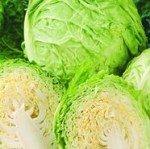 Cabbage is a cool weather crop so the number of days to harvest can be a very important factor in determining what variety of cabbage to grow. The “Express” in this cabbage’s name tells you that this cultivar is speedier than most other cabbages. At 55 days from transplanting to harvest ‘Savoy Express’ is very quick growing. The ‘Savoy’ is the kind of cabbage that tells you it has a round, compact head with crinkled and curled leaves. Like other Savoy cabbages, ‘Savoy Express’ has a milder, sweeter flavor with no bitterness and is more tender than common cabbage. The heads make excellent cole slaw or addition to soup and other cooked dishes. The compact plants can be grown closely making this an excellent cultivar for small gardens. An All American Selection Winner in 2000, ‘Savoy Express’ is recommended for spring and fall planting.
Cabbage is a cool weather crop so the number of days to harvest can be a very important factor in determining what variety of cabbage to grow. The “Express” in this cabbage’s name tells you that this cultivar is speedier than most other cabbages. At 55 days from transplanting to harvest ‘Savoy Express’ is very quick growing. The ‘Savoy’ is the kind of cabbage that tells you it has a round, compact head with crinkled and curled leaves. Like other Savoy cabbages, ‘Savoy Express’ has a milder, sweeter flavor with no bitterness and is more tender than common cabbage. The heads make excellent cole slaw or addition to soup and other cooked dishes. The compact plants can be grown closely making this an excellent cultivar for small gardens. An All American Selection Winner in 2000, ‘Savoy Express’ is recommended for spring and fall planting.
Days to Harvest: 55
Planting Date: Seed can be started indoors 5-6 weeks before the last frost but buying seedlings is much more practical for the home gardener. Set transplants out doors 2 weeks before the last frost date in spring and 42 days before the first frost date in late summer for a fall crop. Cabbage can take some frost but should not freeze.
Spacing: Seeds should be planted ¼-1/2” deep, 1 inch apart and thin to at least 1’ apart. If transplants are used space at least 1’ apart.
Germination: 5-14 days
Size: 1’
Light: Full sun
Water: Water regularly.
Soil: Fertile, moist, well-drained.
Fertilizer: Frequent light applications of high nitrogen fertilizer.
Care: Mulch to keep soil cool and moist. Begin harvesting when head is firm and softball size but cutting just beneath the head and above the lowest leaves. Continue to water and you may get a second crop of small but still tasty cabbages.
Pests and Diseases: Cut down on pest problems by growing cabbage in different parts of the garden every year. Yellow and fusarium wilt, blackleg, black rot, aphids, cabbage worm, larva of white cabbage butterfly, root maggot can all be serious problems.
Suitability for Containers: No.
